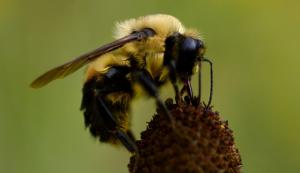Survey: More than 40 percent of bee hives died in past year
WASHINGTON (AP) — More than two out of five American honeybee
colonies died in the past year, and surprisingly the worst die-off was
in the summer, according to a federal survey.
Since April 2014, beekeepers lost 42.1 percent of
their colonies, the second highest loss rate in nine years, according to
an annual survey conducted by a bee partnership that includes the U.S.
Department of Agriculture.
"What we're seeing with this bee problem is just a loud signal that there's some bad things happening with our agro-ecosystems," said study co-author Keith Delaplane at the University of Georgia. "We just happen to notice it with the honeybee because they are so easy to count."
But it's not quite as dire as it sounds. That's because after a colony dies, beekeepers then split their surviving colonies, start new ones, and the numbers go back up again, said Delaplane and study co-author Dennis vanEngelsdorp of the University of Maryland.
What shocked the entomologists is that is the first time they've noticed bees dying more in the summer than the winter, said vanEngelsdorp said. The survey found beekeepers lost 27.4 percent of their colonies this summer. That's up from 19.8 percent the previous summer.
Seeing massive colony losses in summer is like seeing "a higher rate of flu deaths in the summer than winter," vanEngelsdorp said. "You just don't expect colonies to die at this rate in the summer."
Oklahoma, Illinois, Iowa, Delaware, Maryland, Pennsylvania, Maine and Wisconsin all saw more than 60 percent of their hives die since April 2014, according to the survey.
"Most of the major commercial beekeepers get a dark panicked look in their eyes when they discuss these losses and what it means to their businesses," said Pennsylvania State University entomology professor Diana Cox-Foster. She wasn't part of the study, but praised it.
Delaplane and vanEngelsdorp said a combination of mites, poor nutrition and pesticides are to blame for the bee deaths. USDA bee scientist Jeff Pettis said last summer's large die-off included unusual queen loss and seemed worse in colonies that moved more.
Dick Rogers, chief beekeeper for pesticide-maker Bayer, said the loss figure is "not unusual at all" and said the survey shows an end result of more colonies now than before: 2.74 million hives in 2015, up from 2.64 million in 2014.
That doesn't mean bee health is improving or stable, vanEngelsdorp said. After they lose colonies, beekeepers are splitting their surviving hives to recover their losses, pushing the bees to their limits, Delaplane said.
"What we're seeing with this bee problem is just a loud signal that there's some bad things happening with our agro-ecosystems," said study co-author Keith Delaplane at the University of Georgia. "We just happen to notice it with the honeybee because they are so easy to count."
But it's not quite as dire as it sounds. That's because after a colony dies, beekeepers then split their surviving colonies, start new ones, and the numbers go back up again, said Delaplane and study co-author Dennis vanEngelsdorp of the University of Maryland.
What shocked the entomologists is that is the first time they've noticed bees dying more in the summer than the winter, said vanEngelsdorp said. The survey found beekeepers lost 27.4 percent of their colonies this summer. That's up from 19.8 percent the previous summer.
Seeing massive colony losses in summer is like seeing "a higher rate of flu deaths in the summer than winter," vanEngelsdorp said. "You just don't expect colonies to die at this rate in the summer."
Oklahoma, Illinois, Iowa, Delaware, Maryland, Pennsylvania, Maine and Wisconsin all saw more than 60 percent of their hives die since April 2014, according to the survey.
"Most of the major commercial beekeepers get a dark panicked look in their eyes when they discuss these losses and what it means to their businesses," said Pennsylvania State University entomology professor Diana Cox-Foster. She wasn't part of the study, but praised it.
Delaplane and vanEngelsdorp said a combination of mites, poor nutrition and pesticides are to blame for the bee deaths. USDA bee scientist Jeff Pettis said last summer's large die-off included unusual queen loss and seemed worse in colonies that moved more.
Dick Rogers, chief beekeeper for pesticide-maker Bayer, said the loss figure is "not unusual at all" and said the survey shows an end result of more colonies now than before: 2.74 million hives in 2015, up from 2.64 million in 2014.
That doesn't mean bee health is improving or stable, vanEngelsdorp said. After they lose colonies, beekeepers are splitting their surviving hives to recover their losses, pushing the bees to their limits, Delaplane said.



No comments:
Post a Comment
Please leave your comments on this post below. Have a new question? Email it to joyce@suffieldbeeworks.com and we will post it here.